|
Copyright © 2015 David Silver.
THE 1896 POCKET ZAR BEFORE THE BROWNIE, A SIMPLE CARDBOARD BOX CAMERA FOR THE MASSES! by David Silver 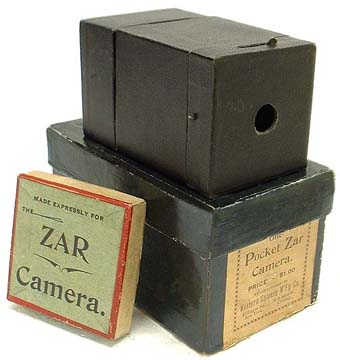 A perfect Pocket Zar boxed set from late 1897. Much has been written about the impact of Eastman Kodak's original Brownie box camera when it entered the market in 1900. Historians have noted Frank A. Brownell's ingenious cardboard box design, the attractive faux leather covering, the simple shutter, and, most of all, the amazing $1 price tag. For the first time, as the advertisements claimed, children and people with limited income could afford a camera of their own, and the world of photography was open to everyone. Yet history often forgets that there were earlier similar attempts to make photography available to the masses, that the concept of a little black cardboard box camera was not Brownell's alone, and that the Pocket Zar of 1896 was one of the more remarkable of those prior efforts. The Zar Camera Company of Chicago was established in a factory at 23 Quincy Street during the spring of 1896. Located in the heart of the city's expanding photographic industry, the fledgling firm was founded as a collective endeavor by a small group of investors and engineers who would further labor and speculate in other important local photographic businesses, including the Western Camera Manufacturing Company around the block at 84 Adams Street and the nearby Vive Camera Company at the corner of State and Washington streets. While primarily intended as a convenient secondary site for outsourcing the assembly of Cyclone, Vive, and Yale plate cameras, Zar was also allowed to function independently, eventually supplying entry level snapshot cameras to other small marketing firms, but most importantly designing and selling its own notable little camera which shared the company name. 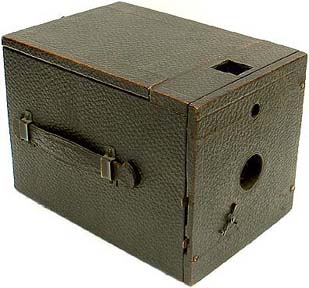 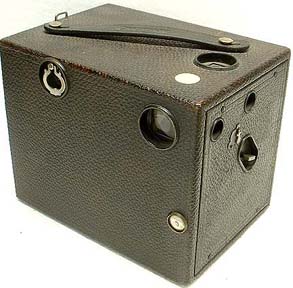 An early 1897 Vive dark-sleeve box camera, and an 1898 Cyclone drop plate camera from Western, two models possibly manufactured and assembled at times, in whole or in part, in Zar's Quincy Street factory. The 1896 Pocket Zar was a miniature glass plate box camera that brought an intriguing new dimension to the concept of simplicity in photographic design. The body was entirely constructed in cardboard, a material never used to such an extent in cameras before, and assembled in three sections. The front part was a square panel to protect the lens and shutter, and was attached by a pair of tacks. The center section was the bulk of the camera, supporting the spring activated shutter and the single element meniscus lens. The rear piece was a boxy cover that slid over the back. All of this was finished attractively with a thin paper application simulating fine grain leather. Measuring only 3 3/4 inches long, 2 1/4 inches high, and 2 1/4 inches wide, this was truly a "pocket" sized camera. What's more, it weighed a mere 3 ounces. Its only decorative flourish was a nicely embossed "Zar Camera" in fancy lettering on the back. 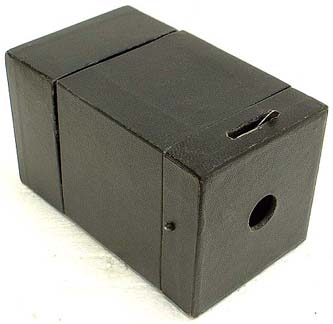 The Pocket Zar was produced in its original form from 1896 to early 1899. Using individual 2 by 2 inch glass plates, the Pocket Zar was as simple in function as it was in appearance. In a darkroom the back of the camera was removed, a single glass plate, made especially for the Pocket Zar, was dropped into the back, and all of this slid onto the rear of the body. Yes, the glass plate was held there only by the pressure fit of the back against the rear flange of the body! To expose the picture the photographer first placed a finger over the lens opening, with a finger of the other hand pulled and held the shutter release lever against the slight pressure of an internal spring, removed the obstructing finger, aimed the camera, and let go of the lever. Yes, the shutter was neither cocking nor self-capping! After exposure the photographer returned to a darkroom to store the negative for later processing and to reload the camera. Simplicity, thy name is Pocket Zar! 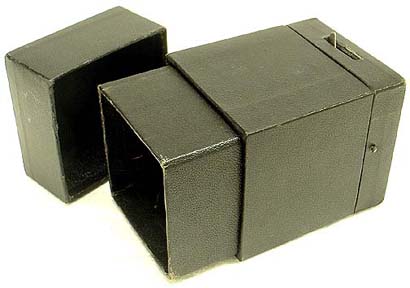 The sinple sliding box construction of the Pocket Zar. 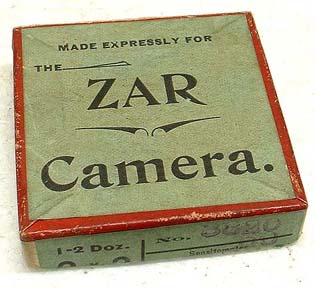 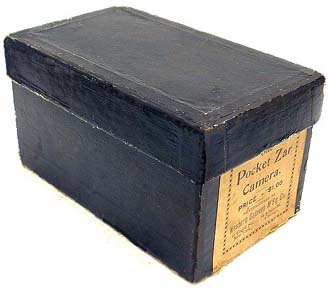 Glass plates for the Pocket Zar on the left, and on the right a later style box for the Pocket Zar with the Western Camera Manufacturing label. The original inspiration for the Pocket Zar is an issue for debate, since no patent was ever applied and the company's greater emphasis remained on its irregular manufacturing obligations with other controlling firms, but it's evident that the Pocket Zar met with reasonable success. Despite its Spartan details and extreme cost cutting features, it was a surprisingly well-made and sturdy little performer, selling well enough through a number of major outlets, including Sears Roebuck and Chicago Photo Supply. Within the first year of production, other companies began inquring into the availability of similar "buck box" cameras from Zar that could be sold under their own various names and brands. Zar complied when they could and took on many consignments, but given the limited profit potential in such wholesale arrangements, they proffered a less ambitious design, a "poor man" version of the Pocket Zar, that could be stamped out and assembled more quickly and at even lower initial cost. These tended to depend on less stable two-piece rather than three-piece bodies, with the shutter pivot pinned through the front by an obvious brass rivet, and poorly fitted faux leather paper covering. One of the first concurrent name variants of the lesser Pocket Zar design, the Souvenir Camera, was made for and sold by the Vive Camera Company beginning early in 1897, mostly for premium giveaways. Although it bore the unmistakable mark of Zar construction, it lacked the same minimal quality control and is usually found today with loose covering or saggy cardboard. Another early consignment was to Zar's Chicago neighbor, the Metropolitan Supply Company (not to be confused with the much later Metropolitan Industries, which was best known in the 1930's for the variety of cheap plastic "minicams" they produced), which sold its own acquired Zar clones as the ambitiously named King Camera and the Wonderful Camera, both of which are uncommon and fairly valuable today. The real genius of the Pocket Zar was in its cost and presentation. It's true, and still remarkable, that Eastman Kodak only charged a dollar for their original Brownie camera in 1900, but in 1896 the Pocket Zar cost a dollar as well, and with free delivery! A six shot roll of film for the Brownie was only fifteen cents, but a box of one dozen glass plates for the Pocket Zar was just twenty cents! What's more, for an additional dollar you could buy an entire developing outfit for the Pocket Zar that included a ruby darkroom lamp, two trays, a bottle of developer, a package of fixing powder, a printing frame, two dozen sheets of printing paper, and a dozen pieces of photographic card stock! In this way the concept of an affordable camera for the masses was taken to a level never achieved before, and hardly matched by the later Brownie. In 1897 the Western Camera Manufacturing Company saw promising initial success with its Cyclone series of glass plate box cameras, and boldy opened an additional headquarters in New York. Later that year, as the major investor, it absorbed and took full control of the Zar Camera Company to simplify its own manufacturing chain of command, but continued marketing the Pocket Zar under the Western label through its main Adams Street location. The Pocket Zar remained in production at Quincy Street even after Western established a larger factory and warehouse towards the end of 1898 further down Adams Street on the corner of Wabash Avenue, but that move was the beginning of the end for the Pocket Zar in its original incarnation. In 1899 Western joined in the creation of the mammoth Rochester Optical and Camera Company, a consolidation of several established yet struggling photographic firms in the east, and they decided to abandon the Pocket Zar, as well as any interest in the old Quincy Street facilities, in favor of their more upscale Cyclone models and new industrial base in New York. The irony of this decision is that the consolidating companies were compelled to share their resources specifically to compete with Eastman Kodak's growing dominance in the American photographic scene. However, the next year Kodak introduced their first Brownie camera, in many ways a veritable clone of the neglected Pocket Zar, which became one of the most successful and best selling camera lines in history, and possibly the final nail in the collective coffin of those other companies. In a stunning business coup, George Eastman later purchased the Rochester consortium outright in 1903, making it a subsidiary manufacturer for Kodak, and the Cyclone line was among the cameras immediately discontinued. In the meantime, with most of the "buck box" jigs and equipment still in place on Quincy Street, and with many of the original working remnants and Zar working staff still available, the Metropolitan Supply Company invested its meager bankroll to take over the abandoned Zar wholesale manufacturing role, and possibly produce a camera or two of their own as well. For starters, the Vive Camera Company, best known for their Vive dark-sleeve box designs, wanted more of the Souvenir Camera manufactured even after Western left town, but there were also plenty of other small market clients requesting their own variations from the Pocket Zar's progeny. Many new variants soon started appearing late in 1899 for many different local and east coast resellers, and despite slowly declining sales for plate box cameras in general, it was clear that the public was still willing to buy the Pocket Zar concept for a few more years. Among the many additional cameras produced on Zar's old Quincy Street assembly line was the Little Wonder, sold through the Enterprise Camera and Optical Company, a short-lived nearby Chicago firm that was almost certainly an additional retail branch for Metropolitan itself dedicated to the east coast market. Then there was the Niagara Junior, most unusual for being a slightly larger version of the earlier Pocket Zar three-piece design, for 2 1/2 x 2 1/2 inch plates, created for sale through the Niagara Camera Company of Buffalo, New York. Today it's one of the more scarce and difficult Pocket Zar clones to find. And highlighting the simplest of the many cameras that were flying off the assembly line of the Quincy Street works was the smallest Yale model sold through the Yale Camera Company located at 37 Randolph Street, just a few blocks away from the original Zar and Western sites. The Yale camera, usually offered for under a dollar, was popular enough to remain available through the first decade of the 20th century, chiefly promoted as a basic yet adequate "student" camera for beginners, but like many before it, it eventually succumbed to the rapidly growing popularity of simple roll film cameras, and in particular the success and influence of the Brownie. 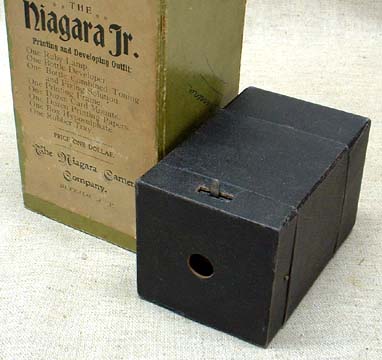 A 1901 Niagara Junior with developing outfit, a scarce larger version of the earlier Pocket Zar design, sold through the Niagara Camera Company of Buffalo, New York. 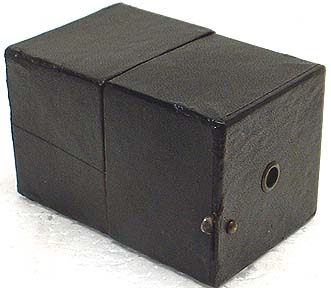 The basic Yale camera of 1905, one of the longest surviving links to the Pocket Zar. There were several more, slapped and tacked and glued together to meet whatever requirements selling agents requested, but perhaps the least common and most desirable descendent of the Pocket Zar remains the elusive later version of the Wonderful Camera, a Metropolitan model mentioned earlier, but now sold through the little known Foto Camera Company, which unlike so many of the other companies in the area, resided on the other side of the Chicago River. Operating out of an office on old May Street south, period business records in Chicago indicate the Foto Camera Company primarily devoted itself to inexpensive amateur developing and processing kits, but was in reality nothing more than a marketing front that only existed for a short time around 1908. More likely it was a tax or debt sheltered last gasp for Metropolitan, safely harbored from the aging Quincy Street Zar location and the accelerating market decline. Still, the Wonderful Camera is the very essence of the Pocket Zar in its final incarnation, with the simpler two-piece body, external rivet pivoting shutter, and very thin paper covering. In over forty years of collecting and researching the history of photography, the author has only seen two surviving intact examples of the Wonderful Camera with the exceedingly rare Foto Camera Company provenance, and next to nothing about the Foto Camera Company itself. Wonderful indeed! With the simultaneous disappearance of both Metropolitan and the Foto Camera Company, and after the last batch of Yale cameras were shipped and stocked for 1909, the Quincy Street factory closed down for good, and the Pocket Zar's direct evolutionary line came to an end. 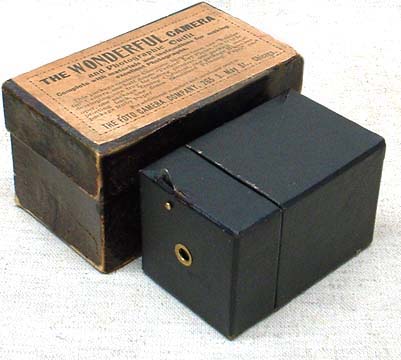 The extremely rare Wonderful Camera as sold through the Foto Camera Company of Chicago, possibly the last gasp of the Pocket Zar evolutionary line, and a valuable coveted treasure for collectors today. The original Brownie camera of 1900 improved on the Pocket Zar's cost-cutting cardboard concept with the addition of a self-capping reciprocating shutter and the use of roll film rather than glass plates. Otherwise, it was so similar in size and detail that for a very brief period it even copied the sliding back section of the earlier camera until Eastman Kodak decided to abandon that feature for a more durable rear door. Frankly, Mr. Brownell, the similarities were all too obvious! 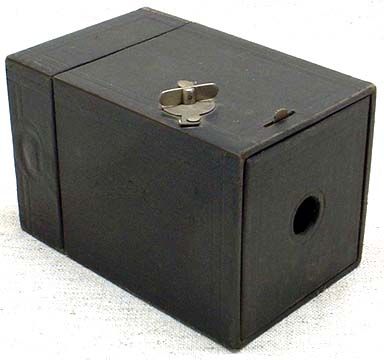 The original Brownie Camera of 1900 from Eastman Kodak. There is no doubt that Kodak's original Brownie deserves its place as one of the most significant advancements in the evolution of camera technology, an innovation in simplicity that shook photography to its core and drove the market forward, but we should never forget its predecessors and prior influences. Among those, the Pocket Zar stands as one of the most important. Produced well before the Brownie, it paved the way to offering affordable photography to the masses, and today represents an especially desirable and valuable artifact for collectors and historians. 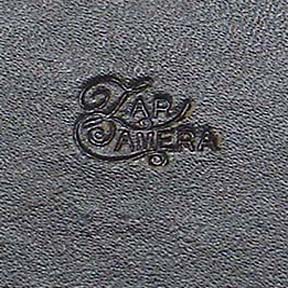 The 1896 Pocket Zar imprint. Copyright © 2015 David Silver. All rights reserved. The original version of this article first appeared in the June 2005 (issue #156) Camera Shopper magazine, and was later significantly expanded and updated in 2012, and again in 2015. If you would like to reprint this article, acquire secondary rights, or inquire into the availability of new articles, please contact the author directly at silver@well.com, thank you! BACK to the International Photographic Historical Organization articles page! GO TO the International Photographic Historical Organization home page! CONTACT the moderator, David Silver, for more information! |